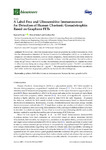A Label-Free and Ultrasensitive Immunosensor for Detection of Human Chorionic Gonadotrophin Based on Graphene FETs
| dc.contributor.author | Islam, Kamrul | |
| dc.contributor.author | Suhail, A | |
| dc.contributor.author | Pan, Genhua | |
| dc.date.accessioned | 2017-08-01T12:57:26Z | |
| dc.date.available | 2017-08-01T12:57:26Z | |
| dc.date.issued | 2017-07-12 | |
| dc.identifier.issn | 2079-6374 | |
| dc.identifier.issn | 2079-6374 | |
| dc.identifier.uri | http://hdl.handle.net/10026.1/9659 | |
| dc.description.abstract |
<jats:p>We report on a label-free immunosensor based on graphene field effect transistors (G-FETs) for the ultrasensitive detection of Human Chorionic Gonadotrophin (hCG), as an indicator of pregnancy and related disorders, such as actopic pregnancy, choriocarcinoma and orchic teratoma. Pyrene based bioactive ester was non-covalently anchored onto the graphene channel in order to retain the sp2 lattice. The G-FET transfer characteristics showed repeatable and reliable responses in all surface modifying steps using a direct current (DC) readout system. The hCG concentration gradient showed a detection limit of ~1 pg·mL−1. The proposed method facilitates the cost-effective and viable production of graphene point-of-care devices for clinical diagnosis.</jats:p> | |
| dc.format.extent | 27-27 | |
| dc.format.medium | Electronic | |
| dc.language | en | |
| dc.language.iso | eng | |
| dc.publisher | MDPI AG | |
| dc.subject | field effect transistor | |
| dc.subject | graphene | |
| dc.subject | human chorionic gonadotrophin | |
| dc.subject | immunosensor | |
| dc.subject | Biosensing Techniques | |
| dc.subject | Chorionic Gonadotropin | |
| dc.subject | Female | |
| dc.subject | Gold | |
| dc.subject | Graphite | |
| dc.subject | Humans | |
| dc.subject | Pregnancy | |
| dc.subject | Transistors, Electronic | |
| dc.title | A Label-Free and Ultrasensitive Immunosensor for Detection of Human Chorionic Gonadotrophin Based on Graphene FETs | |
| dc.type | journal-article | |
| dc.type | Journal Article | |
| plymouth.author-url | https://www.ncbi.nlm.nih.gov/pubmed/28704926 | |
| plymouth.issue | 3 | |
| plymouth.volume | 7 | |
| plymouth.publication-status | Published online | |
| plymouth.journal | Biosensors | |
| dc.identifier.doi | 10.3390/bios7030027 | |
| plymouth.organisational-group | /Plymouth | |
| plymouth.organisational-group | /Plymouth/Faculty of Science and Engineering | |
| plymouth.organisational-group | /Plymouth/Faculty of Science and Engineering/School of Engineering, Computing and Mathematics | |
| plymouth.organisational-group | /Plymouth/REF 2021 Researchers by UoA | |
| plymouth.organisational-group | /Plymouth/REF 2021 Researchers by UoA/UoA12 Engineering | |
| plymouth.organisational-group | /Plymouth/Users by role | |
| plymouth.organisational-group | /Plymouth/Users by role/Academics | |
| dc.publisher.place | Switzerland | |
| dcterms.dateAccepted | 2017-07-03 | |
| dc.identifier.eissn | 2079-6374 | |
| dc.rights.embargoperiod | No embargo | |
| rioxxterms.funder | EPSRC | |
| rioxxterms.identifier.project | Novel Point-of-Care Diagnostic Techniques for Dementia | |
| rioxxterms.versionofrecord | 10.3390/bios7030027 | |
| rioxxterms.licenseref.uri | http://www.rioxx.net/licenses/all-rights-reserved | |
| rioxxterms.licenseref.startdate | 2017-07-12 | |
| rioxxterms.type | Journal Article/Review | |
| plymouth.funder | Novel Point-of-Care Diagnostic Techniques for Dementia::EPSRC | |
| plymouth.oa-location | http://www.mdpi.com/2079-6374/7/3/27 |


